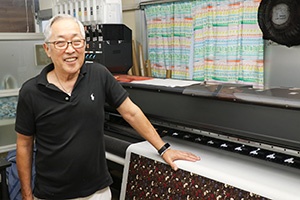
Select your region×
Japan
Europe
Asia Oceania
North America
South America
Case Study
Makers' Inc. Makers' Base Chiba (Chiba City, Chiba) : TS30-1300
Challenges
Improvements
We wanted to introduce to our studio a textile printer that allows to express envisioned ideas more easily than honzome-dyeing, silk screen and digital textile printing.
With the user-friendly sublimation transfer, we gained the ability to visualize free imaginations directly on textiles, being free from design limitations. We can print it on site and immediately start sewing, which is convenient for workshop and well-received by beginners.
Product installed
Nishidasousenkoujo Co., Ltd. (Kyoto City, Kyoto) : Tx500-1800B
Challenges
Improvements
We have operated full-color digital printing, mainly of sublimation transfer. However, as it can print only on polyester, we have been unable to respond to customers' requests for print on natural materials.
With the sublimation transfer printer that allows printing only on polyester, we used to fail to receive orders for print on natural materials, which is now possible. Supporting wider range of materials allowed us to receive order of new products.
Product installed
Challenges
Improvements
Seeking for an edge as a textile retail shop
We succeeded in enhancing our ability to respond to diversified customers' needs by small-lot production of original textiles with shorter delivery time by inkjet printing. For bulk orders as well, producing a small quantity of samples allows us to drive business negotiations smoothly, which raised the order ratio.
Product installed
Kiyoshi Print (Yokohama City, Kanagawa) : Tx300P-1800
Challenges
Improvements
We hope to realize digitalization so we can respond to a wider range of needs utilizing the hand textile printing techniques.
As the device does not need plates, it can handle small-lot production of diversified products, which realized shorter production time. Unlimited number of printed colors widened the scope of design possibilities.
Product installed
IMAGE MAGIC Inc. (Itabashi-ku, Tokyo) : TS55-1800
Challenges
Improvements
2-liter ink packs cannot cope with all-night output sessions. Reduction of operator intervention requirements is also an issue.
The 10 kilogram ink supply unit facilitates extensive duration unmanned output operations in the night time. The unit concurrently enhances the work efficiencies of operators.
Product installed
OGAWA TEXTILE CO., Ltd. (Chiyoda-ku, Tokyo) : JV300 (Sublimation transfer model)
Challenges
Improvements
Reduction of cost, including the time and money taken for outsourced trial printing, and exploration of possibilities of textile design that has many restrictions.
In-house trial testing has resulted in cost reduction in terms of time and money and in improved proposal quality. Digitizing opens up limitless possibilities for new textile design expression.
Product installed
Avon Graphics (Rowville VIC, Australia)
Challenges
Improvements
“Quality is everything for us,” Tate says. “It’s what our clients expect from us and we simply have to deliver. That’s why we don’t rush into new technologies – we have to be sure that it will deliver the best results for our clients, in the turnaround times they need and at a price that represents real value for them – particular as they are ‘on-selling’ our service to their clients.
“Mimaki printers produce as close to offset quality as I’ve ever seen on an inkjet machine, and our customers were immediately delighted with the samples we showed them,” Tate says. “Since then, that quality together with the broad range of products we have been able to offer – which to date has included everything from sign and display, to POP and posters up to A1 in size, polypropylene diary covers and even short runs of ganged-up business cards – has seen this division of our business grow exponentially.”
Product installed
Collaboration with "JAPANTEX 2017 Digital Print Exhibition"
Collaboration
Efforts of Mimaki
"JAPANTEX 2017 Digital Print Exhibition" Organization by THE TEXTILE DESIGN ASSOCIATION OF JAPAN (TDA)
Mimaki textile printer, Tx300P-1800 and Tx300P-1800B realized the direct print of 22 types of design data to each 4 meter cotton fabric.
Product used
Mimaki sublimation transfer system is active at the topic fashion FAB space "andMade"!
Collaboration
Efforts of Mimaki
"andMade.kitasando", Japan's largest fashion FAB, specializing in clothing creation
Introduced CJV150 Series (Inkjet printer with a selection of sublimation transfer ink) as a textile printer and printed original design of customers.
Product used
Collaboration
Efforts of Mimaki
Artist: Yumie Shirai, SANTO MYUZE (Ueda municipal art museum)
Cooperated in the print of her work "Oto-maku (Windscreen)".
Product used









